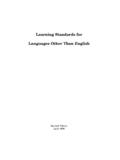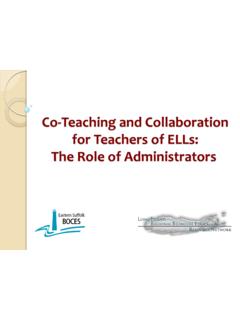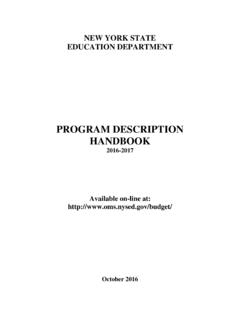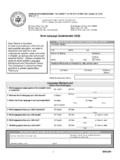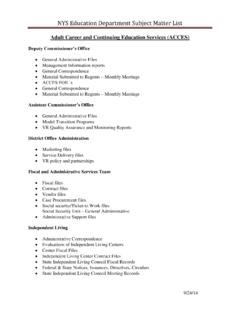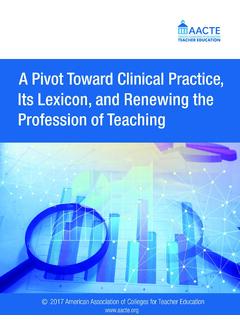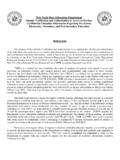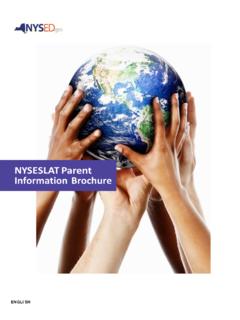Transcription of NYS Next Generation Learning Standards: Leading Advanced ...
1 NYS Next Generation Learning standards : Leading Advanced literacies Instruction For the 21st Century NONIE K. LESAUX, PHD NOVEMBER 30, 2017 SARATOGA SPRINGS, NY Backdrop for Today s Session Lesaux NYSED conference ( ) - for participant use A MULTI-YEAR PARTNERSHIP WITH NEW YORK STATE DEPARTMENT OF EDUCATION OUR LATEST COLLABORATION: WHAT DOES A NEW SET OF standards IN THE CONTEXT OF TODAY S LITERACY DEMANDS MEAN FOR INSTRUCTION? Backdrop for Today s Session: Map of the Brief Series Lesaux NYSED conference ( ) - for participant use This Morning s Session s Literacy Context Primer on Reading Comprehension literacies for Academic Success Advanced literacies in Today s Classrooms Lesaux NYSED conference ( ) - for participant use Today s Literacy Context Lesaux NYSED conference ( ) - for participant use Today s Literacy Context Rethinking literacy What counts as literate on the rise Increasingly sophisticated literacy skills needed to thrive day-to-day Demands communication (orally and in writing) in diverse ways and with diverse audiences.
2 Requires a need to understand and use print for a variety of purposes Is much more than decoding and understanding print New role of language and literacy skills in society in our neighborhoods and in the global world Lesaux NYSED conference ( ) - for participant use Increasing Cultural & Linguistic Diversity Today s Literacy Context Rethinking literacy Increasing Rates of Poverty Quality of Learning environments & opportunities Lesaux NYSED conference ( ) - for participant use Compromised opportunities to develop: language and reading skills strong emotional, social, and cognitive skills High rates of special education placement and dropout 34 21 16 34 4 0 10 20 30 40 50 All children Latino Black or African American Eligible for free or reduced price lunch English language learners Percentage at or above proficient Today s Literacy Context: 8th Graders Department of Education, Institute of Education Sciences, National Center for Education Statistics, National Assessment of Educational Progress (NAEP), various years, 1990 2015 Reading Assessments.
3 Changing Demands of Workforce Participation Work tasks in the economy (1960-2009) Murnane & Levy, 2013 Lesaux NYSED conference ( ) - for participant use Computerized work has ratcheted up the definition of foundational skills. As knowledge has become more abstract, the average person s earnings have become increasingly correlated with educational attainment. Changing Demands of Workforce Participation In order to prepare young people to do the jobs computers cannot do, we must re-focus our education system around one objective: giving students the foundational skills in problem-solving and communication that computers don t have. Lesaux NYSED conference ( ) - for participant use Murnane & Levy, 2013 Changing Demands of Workforce Participation u Business leaders report a steady decline in workplace literacy skills u Private sector spending approx.
4 Billion a year on bolstering entry-level workers literacy skills u 21st Century workers need to clearly communicate (in speech and writing) with a wide variety of audiences, and efficiently manage the abundant information that defines the digital age. Lesaux NYSED conference ( ) - for participant use What about the Higher Education Context? u Average college coursework requires 80 pages of independent reading per week u Up to 60% of community college freshmen assigned to remedial reading courses u 4-year colleges re-organizing freshman year curriculum offerings to provide reading and writing support u Increasing emphasis on group projects, innovation challenges, hack-a-thons, etc. Lesaux NYSED conference ( ) - for participant use Mapping Workforce Demands to Curriculum Design u Team-based, project-based approaches u Emphasis on building up conceptual reasoning skills and background knowledge across subject areas u Emphasis on oral and written communications meant to convey knowledge and reasoning to others u Emphasis on solving unstructured problems u , several potential solutions, weighing trade-offs against priorities to arrive at best solution Lesaux NYSED conference ( ) - for participant use Summary: Today s Literacy Context school-age population is increasingly linguistically, culturally, and economically diverse.
5 Counts as literate today is on the rise. u Unlike past decades, reading and writing have become prerequisites for participation in nearly every aspect of day-to-day, 21st-century life. design of literacy instruction today has not kept pace with this shift from the need for basic to Advanced literacy. more systems-level, strategic approach is needed. Lesaux NYSED conference ( ) - for participant use A Primer on Reading Comprehension Brief 2: What Goes into Effective Reading Comprehension? Lesaux NYSED conference ( ) - for participant use Passage Analysis Shark Facts: A 3rd Grade Text There are almost 400 different kinds of sharks. Each kind of shark looks different, has a unique diet, and behaves differently. There are sharks in all four oceans of the world.
6 Some sharks are longer than a school bus, while others are so small they can live in fish tanks. Sharks come in all kinds of colors. Most of the time, their skin color helps them blend in with their surroundings. But, some sharks that live in the deepest part of the ocean actually have parts that glow in the dark. Most sharks live in salt water, but some can live in fresh water. All sharks are unique, or have different qualities that make them so special. Lesaux NYSED conference ( ) - for participant use 3 sounds, 1 word: /sh/ /ar/ /k/ ~100 words correct per minute (grade 3) Cognitive strategies Vocabulary Relevant background knowledge Understanding of language Interest and motivation Code-based skills Passage Analysis Spelling pattern: there vs. their There are almost 400 different kinds of sharks.
7 Each kind of shark looks different, has a unique diet, and behaves differently. There are sharks in all four oceans of the world. Some sharks are longer than a school bus, while others are so small they can live in fish tanks. Sharks come in all kinds of colors. Most of the time, their skin color helps them blend in with their surroundings. But, some sharks that live in the deepest part of the ocean actually have parts that glow in the dark. Most sharks live in salt water, but some can live in fresh water. All sharks are unique, or have different qualities that make them so special. Meaning-based Skills Code-Based and Meaning-Based Skills: A Critical Distinction Lesaux NYSED conference ( ) - for participant use Spotlight: Second Grade Classroom u Struggles because of underdeveloped word reading skills ( , code-based skills); she reads each word slowly and laboriously.
8 U Struggles because of underdeveloped vocabulary knowledge as it relates to the passage ( , meaning-based skills); he pauses as he tries to understand the text despite the unfamiliar Age Age 8 Age 140 10 20 30 40 50 60 70 80 90 100 Code-Based Ski(Word Reading)lls Meaning-Based Skills (Word Knowledge)AN EMERGING PROFILE: THE CODE-MEANING GAP National AverageNational Rate of Growth: Word Reading: 135 W-score PointsSample Rate of Growth: 145 W-score PointsRate of Growth: Vocabulary: 45 W-score PointsSample Rate of Growth: 60 W-score PointsLesaux NYSED conference ( ) - for participant use Code-Based and Meaning-Based Skills: A Critical Distinction Developmental Processes Instructional Implications Lesaux NYSED conference ( ) - for participant use Code Meaning Typically mastered by 3rd Develops from infancygradethrough adulthood Constrained, , mastery-oriented Unconstrained, , not masteredRequires sustainedHighly susceptible toinstruction, beginning ininstruction in relatively briefearly childhood throughperiod of timeadolescenceAdvanced literacies for Academic Success Lesaux NYSED conference ( ) - for participant use Advanced literacies for Academic Success u The skills and competencies that enable communication in increasingly diverse ways and promote the understanding and use of text for a variety of purposes Lesaux NYSED conference ( )
9 - for participant use Code-Based and Meaning-Based Skills: A Critical Distinction Code-Based Skills Meaning-Based Skills Phonological Awareness Phonics and Word Recognition Fluency Conceptual knowledge about the world Understand abstract, complex ideas when reading Produce written language about abstract and complex ideas Produce academic language in speech Lesaux NYSED conference ( ) - for participant use Spelling What does Advanced literacy instruction look like across the school years? Vocabulary, Meta-Linguistic Awareness, Cross-Linguistic Facility Academic Vocabulary in the Context of Conceptual Reasoning Lesaux NYSED conference ( ) - for participant use What does Advanced literacy instruction look like across the school years? Reading Multiple Sources, Written Argumentation ConductingResearch,Preparing for aDebate,Technical WritingLesaux NYSED conference ( ) - for participant use Fostering Advanced literacies in Today s Classrooms Lesaux NYSED conference ( ) - for participant use HOW CAN WE PROVIDE ALL LEARNERS WITH ENHANCED OPPORTUNITIES TO BUILD ORAL AND WRITTEN LANGUAGE SKILLS AND DEEPEN THEIR KNOWLEDGE OF ABSTRACT CONCEPTS AND IDEAS?
10 Text- and discussion-based strategies Outdated Guiding Principles for Promoting Literacy u Students Learning academic English at school represent a small subpopulation of learners. u Reality: The school-age population is linguistically diverse. There are 400+ native languages in the , and by 2030, 40% of the school-age population will speak a language other than English at home. u The strengths and needs of English learners and their classmates are distinct and necessarily demand different approaches. u Reality: In many classrooms, the literacy strengths and needs of English learners and their English-only peers are more similar than they are different. Learning academic English, oral and written, should be an instructional priority for all. Lesaux NYSED conference ( ) - for participant use Outdated Guiding Principles for Promoting Literacy u The instructional core is preparing the majority of students to engage in Advanced literacy tasks.

